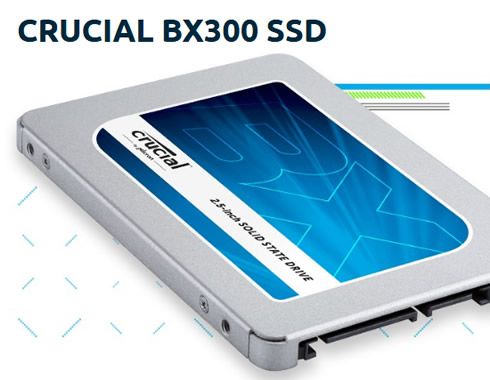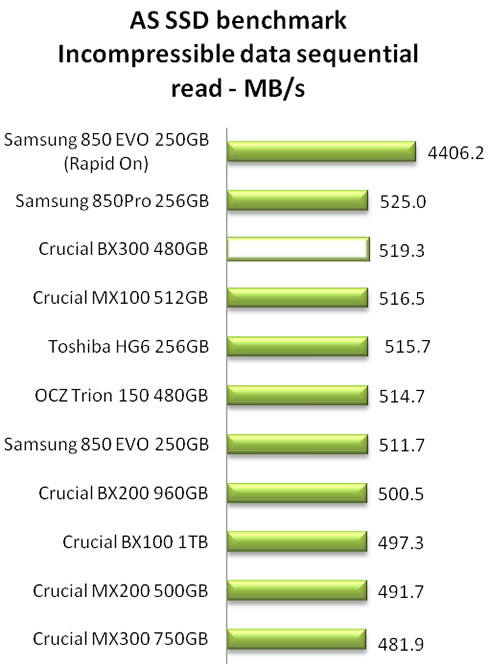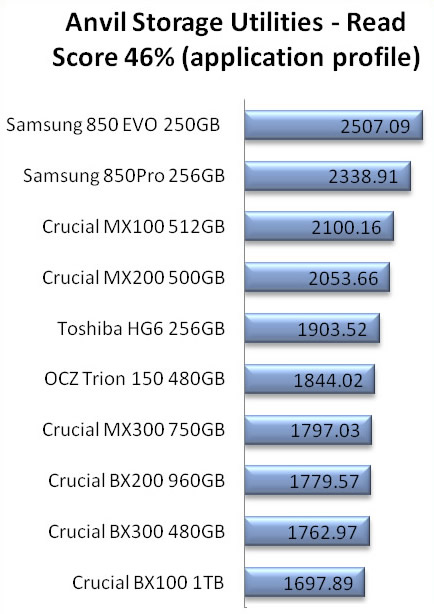1. Features
We have in our hands Micron's second consumer SSD equipped with 3D NAND flash. The BX300 is an entry-level model, available in capacities from 120GB to 480GB using Micron's 256Gb 32L 3D MLC. The series is based on a SM2258 Silicon Motion controller - the same used by ADATA in their SU900 and SX950 SSDs.
Micron introduced the Crucial MX100 in 2014, based on 16nm MLC NAND. The drive offered a great performance for its price. One year later the company came up with the Crucial MX200, which wasn't much of an improvement over the MX100. But at the same time, Crucial introduced the BX100, which used the same 16nm MLC but a cheaper Silicon Motion controller. The specific drive continued to offer good performance. In late 2015, Micron introduced the Crucial BX200 - their first SSD to use TLC NAND. The BX200 reduced price per GB, but sacrificed a great deal of performance and power efficiency in the process. The BX200 faced strong compatition from drives like the ADATA SP550 that used faster and cheaper SK Hynix TLC to undercut the BX200's pricing while offering somewhat better performance. In 2016 Micron's 3D NAND found its way to the Crucial MX300, which used a high-performance Marvell controller and the 3D NAND TLC. The MX300 thus was serving as successor to both the MX200 and BX200, and it has done the job well with good performance and far better power efficiency than any previous TLC SSD.
| Model |
BX200 |
BX300 |
| Controller |
Silicon Motion SM2256 |
Silicon Motion SM2258 |
| NAND |
Micron 16nm 128Gbit TLC |
Micron 256Gbit
32-layer 3D MLC |
| Capacities |
240GB-960GB |
120GB-480GB |
| SLC Caching |
Yes |
Yes |
| Encryption |
No |
| Warranty |
3 years |
| Write Endurance |
72 TB |
55-160 TB |
The Crucial BX300 is Micron's first MLC-based consumer SSD since the Crucial MX200. With the MX200, Micron used SLC caching on smaller capacities and had mixed success-peak performance was boosted, but at the cost of creating more background work for the controller that hurt sustained workloads. For the Crucial BX300, Micron is using relatively small fixed-size SLC caches. Sequential performance and random write performance are rated the same across all three capacities, while random read performance is reduced a bit for the 240GB and is cut in half for the 120GB model. The rated write endurance numbers are lower than the ostensibly higher-end MX300 model. The MX300 does have lots of overprovisioning with which to reduce write amplification, but the BX300 has a reasonable amount too and the advantage of inherently higher endurance from using MLC instead of TLC.

Crucial BX300 |
| Capacity |
120GB |
240GB |
480GB |
| Form Factors |
2.5" 7mm |
| Controller |
Silicon Motion SM2258 |
| NAND |
Micron 256Gbit 32-layer 3D MLC |
| DRAM (DDR3) |
256MB |
256MB |
512MB |
| SLC Write Cache |
4GB |
8GB |
16GB |
| Sequential Read |
555 MB/s |
555 MB/s |
555 MB/s |
| Sequential Write |
510 MB/s |
510 MB/s |
510 MB/s |
| 4KB Random ReadΒ |
45k IOPS |
84k IOPS |
95k IOPS |
| 4KB Random WriteΒ |
90k IOPS |
90k IOPS |
90k IOPS |
| Encryption |
No |
| Write Endurance |
55 TB |
80 TB |
160 TB |
| Warranty |
Three years |
| MSRP |
$59.99 |
$87.99 |
$144.99 |
2. Unboxing, software
The Crucial SSD packaging hasn't changed much over the last several years. The package doesn't list any performance data. and it just lists the warranty and the accessory package.

The overall design is also similar to Crucial's other SSDs. The BX300 features the industry standard 2.5-inch design with a 7mm Z-height.


Under the hood, we found a half-length circuit board with the components configured in a tight arrangement. Crucial populates the 480GB's eight NAND pads with packages. The board only has one pad for a DRAM package, and that means that we should not expect seeing the BX300 come to market in higher capacities.

The Crucial BX300 includes the company's special Storage Executive SSD management software. The software works with Crucial SSDs only. It's also the only way to enable Crucial's Momentum Cache DRAM caching feature. The feature reduces flash wear by using a portion of the system memory to absorb incoming random write data. The software then flushes the data to the SSD as a less-destructive sequential transfer. The software also uses system memory to cache frequently-accessed data, which increases read performance.
Crucial also includes a code for Acronis True Image HD. You can use this software to clone your existing data to a new drive.



3. HDTach, ATTO Disk Benchmark
The HDTach software shows the potential read speed and write which you are likely to experience with the SSD. We see the average speed numbers, which tell you what to expect from a given drive in normal, day to day operations.
The drive's read and write graphs are smooth and stable across its entire capacity. The average read and write speeds were 460 MB/s and 423.6 MB/s, respectively.

The ATTO Disk Benchmark measures storage systems performance with various transfer sizes and test lengths for reads and writes. The benchmark performs file transfers ranging from 0.5 KB to 8192 KB. ATTO can be adjusted to do overlapped I/O, in a variety of queue depths. The test was run with the default runs of 0.5KB through 8MB transfer sizes with the total length being 256MB and QD4. ATTO probably gives the most accurate results for compressible read and write data:

The drive's official Sequential read/write figures for are up to 555MB/s & 510MB/s respectively. Using the ATTO benchmark, the reviewed drive did a little better in the write part, but slowed down a bit in the read tests with files larger tham 128K. This is shown in the read graph below, as you see a dip in the graph for the BX300 after the 128K mark:

TheΒ Crucial BX300 performed very well across the board in the write part, finishing near the top of the stack regardless of the transfer size.

4. CrystalDiskMark
CrystalDiskMark is a disk benchmark utility provides throughput data based on sequential reads and writes, and random (512K/4K/4KQD32) reads and writes of various sizes.


The sequential tests show that the Crucial SSD is able to max out the SATA interface when reading and get very close when writing. This is translated to fast moving of large files in a real-world usage.
Typical inexpensive SSD series canβ??t pass 30MB/s random 4K read while most higher SATA SSD canβ??t make much more than 32-33MB/s. The BX300 offers over 34MB/s what is pretty good result.
For a drive aimed at the value end of the market , the BX300 performs very well dealing with small 4K files at a pretty deep queue depth.
5. AS SSD benchmark
We move on with the AS SSD benchmark, which contains five synthetic as well as three practical tests. The synthetic tests determine the sequential and the random read / write performance of an SSD. These tests are carried out without using the operating system's cache. The Seq-test measures how long it takes to read and write an 1GB file. Most importantly, this sequential benchmark uses incompressible data for all of its transfers.
The Crucial BX300 480GB SSD reached a very high score of of 1243. Sequential speeds for the drive hit the 520MB/s for reads and 480MB/s write while 4K speeds reached 32MB/s for read and 106MB/s for write:


The BX300 SSD goes head to head with the Samsung 850Pro model in the sequential read test:

The BX300 lost some ground in the 4K random read tests, although it remained very competitive. It made an impresive come back in the 4K miltithreaded read test, in which it topped the in the rank:


The performance for the BX300 SSD in the sequential write test was good adn in par with the 850 EVO's result, although not higher than the 850 Pro's:

Both the BX300 and the 850 Evo drives had almost the same performance in the 4K random write test, but Crucial's drive showed its muscles in the 4K/64 thread write benchmark:


Next up we ran the Compression Benchmark built-into AS SSD. This test uses a mix of compressible and incompressible data and outputs both Read and Write throughput of the drive.
The Crucial BX300 SSD showed a stable behavior across the board, with not significant dips in the write graph:

6. IOMeter
The IOMeter benchmark is run by using workstation and database patterns for queue depths (outstanding I/Os) representing very light and moderate loads. Iometer is both a workload generator (that is, it performs I/O operations in order to stress the system) and a measurement tool (that is, it examines and records the performance of its I/O operations and their impact on the system). The app's ability to bombard drives with an escalating number of concurrent IO requests also does a nice job of simulating the sort of demanding multi-user environments that are common in enterprise applications.

Overall, the IOPS delivered by the Crucial BX300 480GB SSD were among the highest we have seen in the specific benchmark, in both read and write tasks:



7. Anvil Pro
The ‘all inclusive’ Anvil Pro software tests transfer speeds as well as IOPS. The IOPS tests can be configurable with preset testing scenarios for read (Seq 4MB, 4K, 4K QD4, 4K QD16, 32K and 128K), write (Seq 4MB, 4K, 4K QD4, 4K QD16) and mixed IO.
We used the software with the Crucial BX300 SSD and tested the drive with 0-fill compression (RAW), 8% compression, 25% compression, 45% compression, 67% compression and finally 100 % (incompressible data).
Somehow the results we got from the Anvil Pro benchmark unveiled a slow performance for the BX300 SSD mainly in the write part.
As you see in the first chart below, the BX300 was fast in the sequential 4MB read test, although it is not ranking in the first places:

The drive was fast in the 4K random read test, but remaind slower than the Samsung 850 Pro 850 EVO SSDs in the rest srandom read tests:

The situation got worse for the BX300 SSD throughout the write tests, although we ran the write benchark many times and even in a different PC. The result was an overall low score in the Anvil Pro suite:





8. PCMark 8 Storage benchmark
We continue with the PCMark 8 Storage benchmark, which uses traces recorded from Adobe Creative Suite, Microsoft Office and a selection of popular games. Unlike synthetic storage tests, the PCMark 8 Storage benchmark highlights real-world performance differences between storage devices.
We ran the storage benchmark test suite:

The Crucial BX300 is a competitor to the 850 EVO in this capacity class, being decent on all fronts.

Drilling down farther, PCMark 8 also has a number of traces that mimic workloads from popular applications. More limited by the SATA interface than intrinsically by the speed of the NAND, the Crucial BX300 rounds out a solid set of results.

9. Summary
The BX300, although it has been designed as a replacement for slow HDD, offers much more than that. The choice of (3D) V-NAND helps the drive's write performance, and armed with dual-caches and the new Silicon Motion SM2258 controller makes it a very competitive drive.
The quoted performance figures for the 480GB BX300 are 555MB/s and 510MB/s for Sequential read/writes respectively. The reviewed drive produced a read figure pretty close to those quoted by Micron, with an expeption with the Anvil Storage software.
Random read/write performance for the 480GB drive is quoted as up to 95,000 IOPS for reads with writeβ??s up to 90,000 IOPS. Our benchmarks generaly confirmed these claims.
The BX300's peak performance is on average slightly below top-tier SATA drives like Samsung's 850 PRO and EVO and the Intel 545s. But this is offset by how well the BX300 retains its performance under heavier workloads and when operating with a nearly-full drive.
With 64-layer 3D NAND still ramping up to full production, Micron has chosen for the BX300 to use their 256Gb 3D MLC that allows for a small SSD to be reasonably fast and free of the downsides of the TLC NAND that dominates the entry-level SSD market.
Surprisingly, Micron is offering its MLC SSD for less than their TLC SSD without making serious compromises. However, Micron is offering just a 3-year warranty for the BX300.
With the MX300 doing so well as a mainstream SSD with entry-level pricing, the focus of the BX line has shifted from being the cheaper option to being the drive designed specifically for the smaller capacities demanded by cost-conscious consumers.
The BX300 is more than typical entry-level SSD. The drive delivers great performance in some cases but still trail the EVOs slightly in some applications and their five-year warranty.
